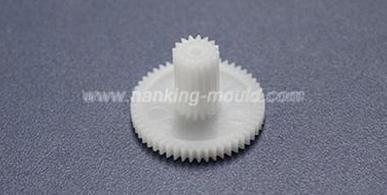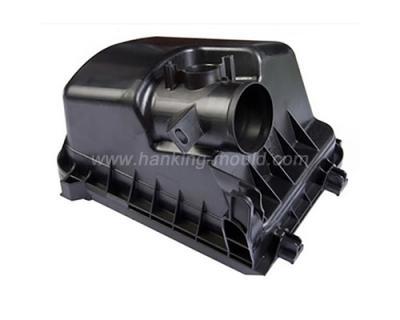

Experience of China plastic injection molding manufacturer with over ten years of experience in demolding injection molded parts.
During the injection molding production process, difficulties in demolding injection molded parts are often encountered. Poor demolding has a significant impact on the quality of injection molded products, and mild demolding may cause surface scratches or patterns on the product; Severe poor demolding can lead to product warping, deformation, and even rupture and damage. So, solving the problem of poor injection molding and demolding affects the quality of the final injection molded product.
After plastic injection molding, the plastic part comes out of the mold cavity. Whether using a single or multiple component ejection mechanism, the demolding work is generally completed in one go. However, sometimes due to the special shape of the injection plastic parts or the need for production automation, it is still difficult to remove the plastic part from the mold cavity or cannot automatically detach after a demolding work is completed. At this time, another demolding action must be added to make the plastic part detach, which is called secondary ejection. The difficulty in demolding is mainly due to the tightening of the gate or plastic part within the mold.
The reasons for the difficulty in demolding injection molded parts include many aspects:
1. In terms of equipment: insufficient ejection force and ejection stroke.
Ejection force is the force control used by injection molding equipment for demolding. For injection molding machines of different importance levels, the maximum ejection force varies. The ideal injection molding process involves a machine with a preset ejection force that is basically sufficient, but it cannot be ruled out that in cases where the custom molding part is larger than the maximum injection molding range or the structure of the injection molding part is too complex, and the gripping force inside the mold is too large. Taking these issues into account comprehensively is beneficial for analyzing the suitability of the ejection force.
2. The reason for poor adhesion and demolding may also be due to the plastic injection mold. As injection mold manufacturer, suggest solving the demolding problem from the following points:
A. The surface of the injection mold cavity is rough.
If there are surface defects such as gouges, scratches, scars, and dents left in the mold cavity and runner, the plastic molded product is easily sticking to the injection mold, causing difficulty in demolding. Therefore, the surface smoothness of the mold cavity and runner should be improved as much as possible. The surface of the mould cavity should preferably be chrome plated. When polishing, the direction of the polishing tool should be consistent with the direction of the molten material filling.
And when the molten material produces flash in the scratched area of the mold or the gap of the insert, it can also cause difficulty in demolding. In this regard, the damaged area should be repaired and the gap between the inserts should be reduced.
B. Insufficient rigidity of the mold.
If the mold cannot be opened at the beginning of injection, it indicates that due to insufficient rigidity of the mold, deformation occurs under the action of injection pressure. If the deformation exceeds the elastic limit, the mold cannot be restored to its original state and cannot continue to be used. Even if the deformation does not exceed the elastic limit of the mold, the molten material cools and solidifies under high conditions in the mold cavity, removes the injection pressure, and after the mold restores deformation, the plastic part is clamped by the rebound force, and the mold still cannot be opened.
Therefore, when designing molds, it is necessary to design sufficient rigidity and strength. When testing the mold, it is best to install a dial gauge on the injection mold to check whether the mold cavity and mold base are deformed during the filling process. The initial injection pressure during mold testing should not be too high, and the deformation of the mold should be observed while slowly increasing the injection pressure to control the deformation within a certain range.
When a clamping failure occurs due to excessive rebound force, simply increasing the opening force is not enough. The mold should be immediately set down and decomposed, and the plastic units should be heated and softened before being taken out. For molds with insufficient rigidity, a steel frame can be added on the outer side of the mold to improve rigidity.
C. Insufficient demolding draft angle.
Insufficient demolding draft angle is one of the important reasons for difficulty in demolding. When designing and manufacturing plastic injection molds, sufficient demolding angles should be ensured, otherwise it is difficult for the plastic part to demould. Forcible ejection often leads to warping of the injection molded plastic part, whitening or cracking of the ejection position, etc. The movement of the mold should be relatively parallel to the fixed template, otherwise it will cause the cavity to shift and cause poor demolding. When designing plastic products, the draft angle should be indicated on the drawing, usually between 1 and 2 degrees. In special situations, it is allowed to be above 0.5 degrees.
D. Unreasonable design of ejection mechanism.
If the ejection mechanism has insufficient stroke, uneven ejection, or poor ejector plate movement, it can all lead to the inability of the plastic molded part to demould.
Plastic injection mold manufacturers should try their best to increase the effective ejection area of the ejector pin to ensure sufficient ejection stroke. The ejection speed of plastic injection molded parts should be controlled within an appropriate range and should not be too fast or too slow. The main reason for ejector plate movement is due to adhesion between sliding components.
E. Poor mold venting or mold temperature too high.
Injection mold manufacturers should improve the exhaust conditions of molds and design sufficient venting channels.
F. Difficulties in demolding caused by injection molding process.
a. The barrel temperature is too high or there is too much injection volume. When the mold temperature is too high, the cooling of the molten material in the cavity is not in place, and the volume does not return to the preset size, resulting in the inability of the plastic part to demould;
b. The injection pressure is too high or the holding and cooling times are long. The injection temperature includes the barrel temperature, nozzle temperature, etc. If the temperature is too high, the molten material entering the mold cavity cannot be cooled and formed at the predetermined time, which also affects the demolding effect;
c. Excessive injection volume. When the injection volume exceeds the cavity capacity, it is often referred to as expanding the mold. When too much molten material is injected, it will expand when the pressure is released, causing it to expand tightly on the mold and cannot be removed. Adjusting the injection volume can solve this problem;
d. Improper injection cycle. If the injection pressure is too high, the holding time or the cooling time is too long during injection molding, there is also a risk of difficulty in demolding. Completely cooled products are also not easy to demould, and the injection cycle must be appropriate.






 Call us on:
Call us on:  Email Us:
Email Us:  1st Floor, Block1, No.3 Beiting Road, Houting Community, ShaJing Street, Bao'An District, Shenzhen City, Guangdong Province, China
1st Floor, Block1, No.3 Beiting Road, Houting Community, ShaJing Street, Bao'An District, Shenzhen City, Guangdong Province, China